Myron G. Best. Igneous and metamorphic 2003 Blackwell Science
Подождите немного. Документ загружается.

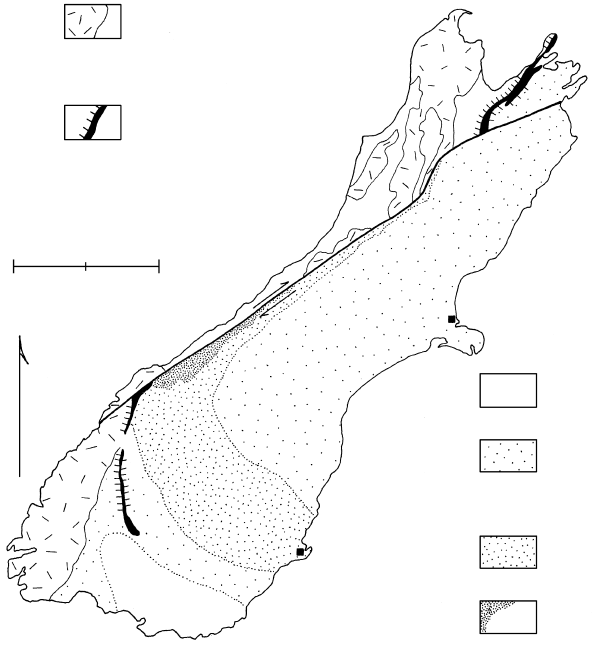
The intimate association of sheared serpentinite
bodies with mélange (Figure 18.28a) and the common
occurrence of serpentine in the sheared matrix suggest
that serpentinite might play a role in the origin and em-
placement of mélange. Several possibilities exist where
the low strength of serpentinite and its considerable
buoyancy (density 2.5–2.6 g/cm
3
at atmospheric con-
ditions) in the presence of denser mafic–ultramafic
rocks (3.0–3.3 g/cm
3
) can potentially lead to mobilized
upwelling masses. At transform zones cutting across
oceanic rifts, fracture-enhanced hydration of ultramafic
rocks apparently creates protrusions onto the seafloor
that subsequently break up into serpentinite detritus.
Dredge hauls reveal larger clasts are cemented by car-
bonate to form ophicalcite, whereas finer detritus and
admixed minor amounts of fossiliferous sediment form
“sedimentary” serpentinite. Coherent blocks of the
disrupted ophiolite sequence tectonically mix into this
soft serpentinite matrix. This serpentinite mélange can
subsequently be accreted onto the overriding land
plate where additional internal brecciation and mixing
can occur. Where subducting oceanic slabs liberate
water, peridotite in the overlying mantle wedge can be
hydrated into serpentinite and mobilized into buoyant
diapirs (Figure 11.16; see also Guillot et al., 2000). As
they ascend, possibly along the wedge–slab interface,
fragments of wallrock can be incorporated (Guillot
et al., 2000). Such diapirs in the Mariana–Izu–Bonin
forearc of the western Pacific have emerged as sea-
mounts or “mud volcanoes” as much as 30 km in dia-
meter and 2 km high on the ocean floor. Recovered
samples from these edifices consist of serpentinite frag-
ments and exotic blocks of rock containing minerals
(lawsonite, crossite, Na-clinopyroxene) equilibrated at
conditions transitional to that of the blueschist facies
(about 400°C, 15–20 km depth) in a mud matrix of
serpentine, chorite, and clay and carbonate minerals
(Fryer et al., 1999; O’Hanley, 1996).
Serpentinite buoyancy likely enhances ascent of
mélange blocks in the Cloos (1982) wedge-flow model
and may be a factor in rapid exhumation of blueschist-
and eclogite-facies rocks equilibrated at depths of
40 km in subduction zones (see below). However,
the exact reason for rapid exhumation that precludes
equilibration to higher T assemblages remains elusive
(Bebout et al., 1996).
18.6.4 Subgreenschist Facies Rocks
Until the pioneering research of D. S. Coombs (1961)
on the thick sequence of volcanogenic clastic rocks in
southern New Zealand (Figure 18.30), little was known
and appreciated regarding low-grade, subgreenschist
Metamorphism at Convergent Plate Margins: P–T–t Paths, Facies, and Zones
597
Calc-alkaline magmatic rocks
and high-T metamorphic rocks
Ultramafic rocks (black) bordered
by lawsonite albite chlorite
blue amphibole assemblages
(hachures)
Prehnite–pumpellyite facies and
unmetamorphosed sediments
Zeolite facies
Z
Z
Christchurch
Greenschist facies
Amphibolite facies
0 100mi
0
N
160km
Dunedin
18.30 Regional metamorphic zones and right-lateral Alpine fault, South Island of New Zealand. Redrawn from Landis and Bishop (1972).

facies metamorphism. Although much remains to be
learned, his conception of the zeolite and prehnite–
pumpellyite facies has withstood the test of innumer-
able subsequent investigations of arc rocks all over the
world.
Investigation of these rocks presents several chal-
lenges. Relict fabrics and minerals of the protoliths are
preserved, seriously hampering the interpretation of
overprinting metamorphic mineral assemblages. Newly
equilibrated low-T minerals are typically very fine
grained and commonly occur as fringes on pre-existing
primary mineral grains. Whether new minerals con-
stitute an equilibrium assemblage can always be ques-
tioned and whether they develop at all depends on the
availability of a penetrating fluid; this is particularly
acute in the case of mafic magmatic rock protoliths that
are initially volatile free. Whereas more permeable sedi-
mentary and tuffaceous rocks, especially where glassy
(Figure 14.2), can experience more pervasive recrystal-
lization resulting from invaded fluids, interlayered
basaltic and andesitic rocks are less susceptible to
equilibration under changing metamorphic conditions.
This is particularly the case where the rock mass re-
mains undeformed without avenues for invasion of
fluids. The composition of the penetrating fluid can
also be crucial; Thompson (1971) showed that only
minute concentrations of CO
2
(X 0.0075) in a
aqueous fluid are sufficient to stabilize calcite kaoli-
nite quartz in lieu of laumontite. Thus, in many
metamorphic terranes possibly flooded by fluids
sufficiently rich in CO
2
, zeolite-facies and possibly
prehnite–pumpellyite-facies assemblages are absent
and the onset of metamorphism is marked by greenschist-
facies assemblages.
Understanding the paragenesis of the zeolite and
prehnite–pumpellyite facies formed under the lowest
P–T conditions of metamorphism provides a perspect-
ive on transitions into the greenschist and blueschist
facies formed at higher T and P (Figure 14.33) that
occur in nearby geologic settings (Figure 14.24). How-
ever, a lack of well calibrated mineral thermobarome-
ters hinders the interpretation of the lower T rocks and
creates inaccuracies in P–T paths. Equilibration, partial
or complete, at temperatures less than closure tem-
peratures also hinders determination of chronologic
aspects of metamorphism.
Zeolite Facies. Although Eskola recognized the low-T
existence of zeolitic mineral assemblages as early as
the 1930s, it was not until Coombs et al. (1959) docu-
mented regular mineralogical zones in regionally ex-
tensive zeolite-bearing rocks in southern New Zealand
(Figure 18.30) that the zeolite facies was proposed.
Here, during the Triassic, locally as much as 9 km of
volcanogenic clastic material accumulated in a subsid-
ing trough adjacent to a volcanic arc. As the thickening
CO
2
pile was subjected to burial metamorphism, the reac-
tive, commonly glassy volcanic detritus recrystallized
into very fine-grained zeolites (Figure 14.3) and other
low-T phases, including albite and epidote. The zeo-
lites stilbite and mordenite developed at shallower
depths and lower temperatures, whereas heulandite
and then laumontite and wairakite formed at higher
temperatures. Miyashiro (1994) considers any equili-
brated assemblage of zeolite quartz to belong to the
zeolite facies.
Prehnite–Pumpellyite Facies. In the deeper part of the
thick Mesozoic pile of arc-derived clastic rocks in
southernmost New Zealand, prehnite and pumpellyite
appear together with laumontite and other zeolites. But
in similar volcanogenic rocks elsewhere in the South
Island of New Zealand, in Japan, and in other areas of
the world, zeolites and quartz are not stable with
prehnite pumpellyite. (Pumpellyite (Table 14.1 and
Appendix A) is a bluish-green epidote-like mineral
with a composition roughly equivalent to epidote
actinolite water.) However, prehnite and pumpel-
lyite occur with epidote chlorite and other phases
typical of the lower greenschist facies, including acti-
nolite, albite, stilpnomelane, white mica, titanite, and
calcite, or with lawsonite albite and other phases
typical of the blueschist facies. Coombs (1961) desig-
nated widespread assemblages of minerals that are
transitional between the zeolite and the greenschist or
blueschist facies the prehnite–pumpellyite facies. Mafic
rocks of this facies typically have a distinct bluish-green
color because of abundant pumpellyite. Schmidt
and Robinson (1997) have made a detailed analysis
of the transition from smectites to chlorites in meta-
basites equilibrated under zeolite- to greenschist-facies
conditions.
Prehnite is not stable in the highest grade assem-
blage of the prehnite–pumpellyite facies that has coex-
isting actinolite pumpellyite chlorite epidote.
This four-phase assemblage would seem to be imposs-
ible in the three-component ACF system of Figure
18.31, but additional components such as Fe
3
and Ti
may account for its stabilization.
The stability field of prehnite pumpellyite ranges
from less than 200°C to about 300°C and from about
4 kbars to 1 kbar, where the two minerals are stabil-
ized in seafloor metamorphic rocks. With increasing
T, these two phases react with chlorite and quartz to
produce epidote actinolite, marking the transition
into the greenschist facies. In rocks poor in chlorite
or quartz, pumpellyite or prehnite can persist stably
into the greenschist-facies regime to temperatures
approaching 400°C. Interpretation of mafic mineral
assemblages that contain pumpellyite, prehnite, epi-
dote, and actinolite is fraught with problems, probably
in part kinetic (Beiersdorfer and Day, 1995).
598 Igneous and Metamorphic Petrology

18.6.5 Metabasites at High Pressures
In contrast to the generally subtle prograde mineralo-
gical changes in metabasites at intermediate pressures
in Barrovian terranes, more pronounced changes occur
in basaltic protoliths as they are subjected to increasing
P at low to moderate T from the prehnite–pumpellyite
facies through the blueschist and eclogite facies (Figure
14.33). Diverse chemical rock groups are represented
in these high-P facies but mafic rocks provide the most
diagnostic mineral assemblages, hence the following
focus on them.
Blueschist Facies. The most obvious mineralogical
contrast between the blueschist and lower P–higher T
facies lies in the nature of the amphiboles in meta-
basites. Whereas green calcic (Ca–Mg–Fe
2
) actinolite
typifies the prehnite–pumpellyite and lower greenschist
facies, the characteristic amphibole of the blueschist fa-
cies is blue sodic (Na–Mg–Fe–Al) glaucophane. This
amphibole has a striking pleochroism in thin section
ranging from colorless to yellow to blue and purple;
in hand sample it is blue to blue-black, hence the
blueschist facies. However, glaucophane solid solu-
tions are stable over a broad range of P–T conditions
not restricted to just those appropriate to the blueschist
facies. Under some conditions, a miscibility gap exists
between actinolite and glaucophane so that they coex-
ist stably in the same rock. Because glaucophane alone
is not indicative of the blueschist facies, its definition
depends on the stable coexistence of lawsonite plus
glaucophane, in contrast to the coexistence of the com-
positionally equivalent albite chlorite actinolite
that is diagnostic of the greenschist facies. (In the long
and controversial history of the validity of the blue-
schist facies, it was known as the more specific, but
more cumbersome, glaucophane–lawsonite facies.)
For a hydrous mineral, lawsonite is surprisingly dense
(3.1 g/cm
3
); its composition, CaAl
2
(Si
2
O
7
)(OH)
2
·H
2
O,
is equivalent to anorthite (density 2.76 g/cm
3
) water.
In basaltic protoliths, lawsonite has been observed to
crystallize directly from magmatic plagioclase accord-
ing to
18.24 CaAl
2
Si
2
O
8
·NaAlSi
3
O
8
2H
2
O →
plagioclase
CaAl
2
Si
2
O
7
(OH)
2
·H
2
O NaAlSi
3
O
8
lawsonite albite
Lawsonite appears to be stable to pressures as low as
3 kbar in some assemblages.
Additional diagnostic minerals of higher P–lower T
assemblages in the blueschist facies include aragonite
and jadeitic clinopyroxene. Pure jadeite quartz is a
stable mineral pair in lieu of pure albite in the higher P
part of the facies. Solid solution with aegerine, diop-
side, and hedenbergite end-members lowers the stabil-
ity P of jadeite and where quartz is absent the stability
P is still less (Figures 16.4 and 16.10). Because of
relatively low temperatures, biotite does not occur,
although the nearly identical (in terms of optical prop-
erties in thin section) stilpnomelane is widespread. The
absence of andalusite and sillimanite in rare blueschist-
facies pelites reflects their high-P stabilization. De-
pending on bulk rock composition, chlorite, titanite,
pumpellyite, Ca–Mg–Fe–Mn garnet, and phengitic
white mica are also found in blueschist-facies metaba-
sites (Figure 18.32).
Some mineral assemblages transitional between the
blueschist and other facies depend on the oxidation
state of the rock. Stabilities of amphiboles and epidotes
are especially affected, such as in the reaction (Evans
and Brown, 1987)
18.25 Na-amphibole epidote
albite chlorite actinolite Fe-oxide
In this reaction, Fe
3
does not substitute appreciably
in any of the silicate phases in the greenschist assem-
blage on the right and, hence, does not perturb its
stability field. However, considerable substitution can
take place in the two phases on the left, extending their
stability field to lower pressures than for the Fe
3
-poor
assemblage of glaucophane zoisite (Yardley, 1989,
p. 106). This effect may explain the intimate interlayer-
ing in some places of schists that are of blue and green
color. Both must have been metamorphosed under the
same P–T conditions, but the schists that contain blue
crossite (a Na–Fe
3
-rich amphibole compositionally
intermediate between glaucophane and riebeckite;
Metamorphism at Convergent Plate Margins: P–T–t Paths, Facies, and Zones
599
CF
Actinolite
Prehnite
Epidote
Pum-
pellyite
a
A
Albite
b
Chlorite
18.31 ACF diagram for higher T part of the prehnite–pumpellyite
facies. Dark shaded ellipses represent compositions of basaltic
rocks (b) and arc andesites and dacites (a).
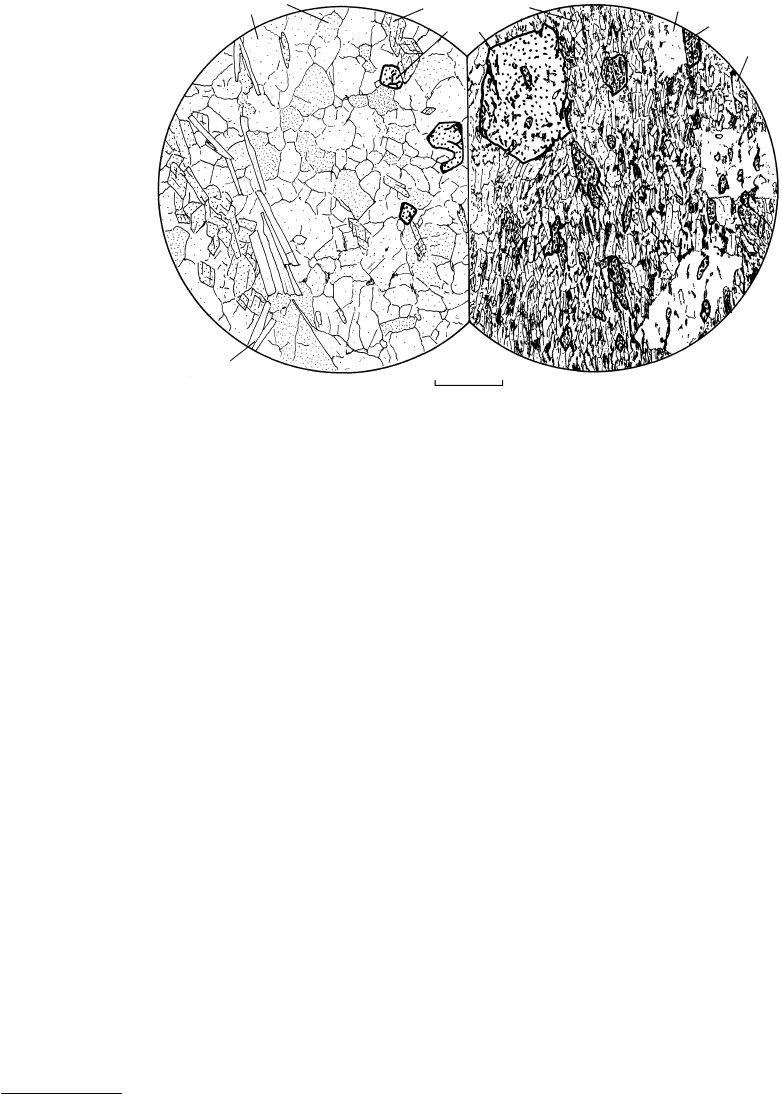
Appendix A, no. 17) developed in oxidized layers and
the green actinolite schists in reduced layers that con-
tain little Fe
3
. Widespread terranes of blue crossite-
bearing rocks, including the Sanbagawa metamorphic
belt in Japan (J. Metam. Geol., 1990, vol. 8, no. 4)
and the Shuksan terrane of the Cascade Mountains
of western Washington (Brown, 1986), are believed to
be transitional in terms of P of formation between
Barrovian-type greenschist-facies rocks and blueschist-
facies rocks that contain the diagnostic assemblage of
glaucophane lawsonite.
Regional terranes of blueschist-facies rocks, some
with mineral assemblages transitional into the lower P
prehnite–pumpellyite facies and/or into the higher P–T
eclogite facies, occur in the main island of New Cale-
donia in the western Pacific Ocean (Yokoyama et al.,
1986), parts of the Alps, and many other subduction
settings (Evans and Brown, 1986). The Franciscan
terrane is probably the best known where blueschist-
facies rocks occur as blocks with less common eclogite
in a typically poorly exposed mud-matrix mélange and
as variably deformed but coherent kilometer-scale
sheets of metasedimentary rock.
Eclogite Facies. Eskola’s studies of the dense eclogites
in the Western Gneiss region of Norway in the early
1900s prompted him to propose a high-P eclogite
facies. However, several problems had to be overcome
before its acceptance today as a valid facies distinct
from other facies. Initially, only metabasites made
essentially of the assemblage omphacite magnesian
garnet were known (Figure 16.9b). Some petrologists
believed that low water fugacities were responsible for
destabilizing hydrous phases diagnostic of other facies,
such as glaucophane and epidote in the blueschist
facies. Whether glaucophane, white micas, epidote
minerals, chlorite, and other hydrous minerals that
occur in some eclogitic rocks belong with the eclogite
facies assemblage or were stabilized during subsequent,
common retrogressive metamorphism (Figure 14.27b)
was problematic; if these hydrous minerals are primary
they indicate a significant amount of water in the
eclogitic system.
Although much has yet to be learned about the
rare but intriguing mineral assemblages of the eclogite
facies, there is consensus that they equilibrate over a
wide range of T, from the 1000°C of mantle-derived
xenoliths to the 500°C of convergent plate associations
—a wider T range than all other facies (Section 15.2.4
and Figure 14.33). Considering the wide range of the
now available chemical rock types (Carswell, 1990,
p. 4), mineral assemblages and their equilibrium P–T
conditions indicate a broad transition between the
eclogite and adjacent facies.
18.6.6 P T t Paths and Tectonic Evolution of
High P/T Terranes
Rocks of the prehnite–pumpellyite, blueschist, and
locally eclogite facies in accretionary wedges record
rapid emplacement of rocks, burial, tectonism, meta-
morphism, and exhumation during plate convergence.
Depositional ages of sediment inferred from rarely
preserved fossils are commonly not much greater than
the isotopic age of metamorphic recrystallization and
thus not much older than the time of exhumation.
Most extensive terranes are Cenozoic or late Mesozoic,
apparently because older ones have been overprinted
by continuing or subsequent higher T metamorphism,
commonly under amphibolite-facies conditions. Such
overprints with only sparse relicts of blueschist-facies
600 Igneous and Metamorphic Petrology
Phengite
0 0.3mm
Chlorite
Titanite
Lawsonite
Glaucophane
Aragonite
Garnet
18.32 Thinly interlayered calc–silicate and mafic schists metamorphosed under blueschist-facies conditions, Franciscan Complex, Laytonville
Quarry, Mendocino County, California. Aragonite has variable relief.
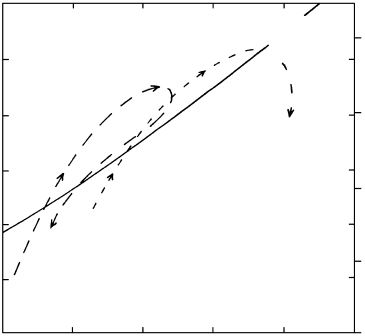
assemblages have been noted in several terranes, such
as in the Appalachian Mountains of Vermont (Laird
and Albee, 1981).
The contrasting tectonothermal processes in con-
vergent plate terranes that, on the one hand, preserve
high-P/T rocks and, on the other hand, produce higher
T metamorphism were first recognized in pioneering
work by Ernst (see 1988). Most such metamorphic
terranes follow P–T paths that move into greenschist-
and locally amphibolite-facies conditions on the retro-
grade segment of their path (Figure 18.33) because of
significant heating before decompression; subduction
of heat-producing continental rocks, as in the Alpine
model in Figure 18.2a, might have been responsible.
In contrast, fewer terranes, such as the Franciscan,
remained refrigerated during exhumation, perhaps
because they were incorporated into rapidly rising, very
buoyant serpentinite diapirs and mélanges spawned in
the hydrating mantle wedge overlying the descending
slab. The corresponding steeper P–T path penetrates
well into the stability field of aragonite, while the ret-
rograde path essentially retraces the prograde at only
slightly higher T, avoids greenschist-facies conditions,
and returns into the field of calcite at low T, perhaps on
the order of 100°C. This sort of refrigerated path may
account for widespread preservation of metastable
aragonite in Franciscan rocks of appropriate com-
position (Figure 18.32a) and its absence in rocks meta-
morphosed to higher T blueschist-facies conditions.
Although some of the latter never enter the stability
field of aragonite, others at lower T do, and because
their path brings them back into the stability field of
calcite at significantly higher T, on the order of 400°C,
transformation to the lower P polymorph is kinetically
effective (Carlson and Rosenfield, 1981).
18.7 ULTRAHIGH-P METAMORPHIC
ROCKS
The occurrence of coesite, albeit exceedingly rare, in
metamorphosed continental rocks (Figure 15.18) has
prompted the recognition of a distinct type of ultra-
high-P (UHP) metamorphism. These terranes equili-
brated in the stability field of this silica polymorph in
excess of about 29 kbars at 800°C (see Figure 18.35).
Even more rare diamond in such terranes constrains
equilibration pressures to at least 38 kbar (about 140 km
depth) at 800°C—the graphite–diamond transition.
Although the rarity of coesite and diamond, which
stems in part from their sporadic preservation, may
limit the recognition of UHP rocks, other mineral
barometers confirm these extreme pressures.
Study of UHP rocks is not an esoteric petrologic
exercise. The ramifications of burial of substantial
terranes of continental rock to depths 100 km into
the denser upper mantle and their subsequent exhu-
mation challenge conventional tectonic concepts. For
example, the deepest Moho today is only about 80 km
beneath the Himalaya orogen. Does this mean that the
Himalayan continent–continent collision zone is unlike
past collision orogens where UHP rocks have been
found? Or, are geophysical determinations of the depth
of the thickened Himalayan continental crust flawed in
some way? How is it possible for any tectonic process
to push relatively buoyant continental rock into the
denser upper mantle? How are such once deeply buried
rocks exhumed? What do UHP rocks tell us about our
conventional notions of how continents grow?
When the first edition of this textbook was pub-
lished in 1982, UHP rocks were unknown. Following
Christian Chopin’s discovery just two years later
(Chopin, 1984) of coesite in silicic continental rocks of
the western Alps and then a few months later by Smith
(1984) in eclogites in the Western Gneiss region of
Norway, such rocks were subsequently found in China
and in a dozen other orogens worldwide (Hacker and
Liou, 1998). The intriguing petrologic implications
and challenges together with the tantalizing tectonic
paradoxes have spawned over one hundred research
articles, several symposium volumes, and at least four
books, clearly making this one of the hottest (or deep-
est, depending on one’s inclinations) topics in geology
of the late twentieth century!
Metamorphism at Convergent Plate Margins: P–T–t Paths, Facies, and Zones
601
P (kbar)
Depth (km)
12
10
8
6
4
2
0
40
30
20
10
0
0 100 200 300 400 500
T (°C)
Arg
Cal
F
r
a
n
c
i
s
c
a
n
BLUESCHIST
GREENSCHIST
18.33 Schematic P–T paths for high-P/T rocks. Generalized fields of
blueschist- and greenschist-facies conditions are indicated.
Aragonite–calcite univariant equilibrium curve from Figure
16.1. Long dashed line depicts a possible path taken by many
Franciscan blueschist-facies rocks. Short dashed line repre-
sents path of blueschist-facies rocks in other terranes that
apparently experience greater heating and consequent equili-
bration of greenschist-facies mineral assemblages. Because
of these higher temperatures, aragonite can transform into
calcite that generally doesn’t happen in the refrigerated
Franciscan rocks because of unfavorable kinetics at low
temperatures. Redrawn from Ernst (1988).

18.7.1 Coesite and Diamond: Diagnostic UHP Minerals
UHP minerals and mineral assemblages are typically
preserved in tectonically emplaced lenses and thin
layers intercalated within lower-P rocks of the amphi-
bolite and greenschist facies. P–T paths can be recon-
structed, sometimes only crudely because of the lack of
pertinent experimental and thermodynamic data, using
disequilibrium mineral assemblages, zoned minerals,
and, especially, mineral inclusions within unreactive
host grains, such as pyropic garnet, jadeitic clinopyro-
xene or omphacite, kyanite, and zircon. These strong
mineral grains served as effective “pressure cells” (Spe-
cial Interest Box 18.2) that preserved the UHP envir-
onment of the inclusion during exhumation of the
rocks. Preserved UHP polymorphs of silica and carbon
provide the most direct barometric insights. Most
coesites have been partially to completely pseudomor-
phed by lower P quartz in distinctive “palisade-textured”
aggregates encased within their host. The larger molar
volume of the replacing quartz commonly ruptured
the host mineral grain during exhumation, creating
surrounding radial expansion cracks (Figure 15.16).
Microdiamonds, generally 0.1 mm in diameter,
also occur as inclusions in garnets in rocks of the
Dabie–Sulu terrane in China and the Kokchetav Com-
plex of northern Kazakhstan. In the Western Gneisses
of Norway (see below), because of their extremely
small abundance, diamonds have only been recovered
by acid digestion of large volumes of rock. Skeptics of
UHP metamorphism have argued that these minute dia-
monds are a contaminant from laboratory processing.
(Rocks are usually cut by diamond impregnated saw
blades and diamond grit is used as an abrasive in pre-
paration of thin sections.) Or, diamonds were formed
at high-stress grain boundaries or by nonequilibrium
factors. But the preservation of diamonds and coesites
as inclusions within some sort of mineral host disproves
both laboratory contamination and high-stress grain
boundary nucleation. Others have argued that diamond
and coesite were somehow stabilized by large nonhy-
drostatic stresses, but this “tectonic overpressure” notion
was discounted decades ago when it was realized how
weak rocks are under metamorphic conditions (Sections
8.2.1 and 17.2.6; see also Stöckhert and Renner, 1998).
Relict mineral assemblages that mostly escaped re-
equilibration at lower P as a result of limited access of
volatile fluids and/or absence of deformation corrobor-
ate ultrahigh pressures inferred from coesite and dia-
mond. For example, the Kokchetav rocks are unique
in containing clinopyroxene grains with exsolution
lamella of K-feldspar; potassic clinopyroxene is stable
only under UHP conditions. Defining assemblages in
classic UHP terranes are considered next for the Dora
Maira Massif of the western Alps and the Dabie–Sulu
terrane of east-central China.
602 Igneous and Metamorphic Petrology
Special Interest Box 18.2 Mineral grains as
“flight recorders” of their geologic history
Everyone has become familiar in recent years with
the “black-box” flight recorder sought in crashed
airplanes that can tell of circumstances leading up
to the crash to aid investigators reconstructing the
event. In a similar way, inclusions embedded in a
mineral grain tell about various aspects of its history.
Garnet porphyroblasts are a useful “flight
recorder” that allow the petrologic investigator to un-
ravel the time-dependent thermobarometric path from
rocks caught up in the orogenic wreckage of plate
collisions (Haugerud and Zen, 1991). The typical long
history of growth of porphyroblasts over millions of
years (see Section 18.2 on the Tauern Window) under
changing metamorphic conditions is recorded in
successive compositional zones (Figure 16.34) that can
potentially yield P–T values using thermobarometric
techniques. “Potentially” is used in the foregoing
sentence because of numerous pitfalls in thermo-
barometry of garnets that arise from complexities in
zoning related to, for example, skeletal growth, dif-
fusional adjustments in compositional zones after
growth, especially at high temperatures, and lack
of original equilibration of Ca concentrations. The
assemblage of mineral inclusions incorporated into
poikiloblastic garnets during growth can be assessed
in petrogenetic grids. In addition to this potential
petrologic information is the opportunity for iso-
topic dating of successive zones of the garnet either
using the Rb–Sr isotope system on the garnet itself
or the U–Pb isotopic system on inclusions of zircon,
rutile, and titanite (see Special Interest Box 19.1).
Amazing discoveries of polymorphs of silica and
carbon stable only under mantle pressures occurring
as inclusions in garnet and other mineral “pressure
vessels” spawned a whole new field of ultrahigh-P
metamorphic petrology in the last 15 years of the
twentieth century. Tectonic models had to be revised
to reconcile the deep burial and rapid exhumation
of the sedimentary protoliths that host coesite
and diamond. Incredibly, details of the history of
continental-scale orogens are obtained from micron-
size mineral inclusions!
In a further step, minute mineral inclusions in dia-
monds hosted in peridotite and eclogite xenoliths
in kimberlite (Section 13.12.2) reveal information
about the mineralogical nature of the mantle.
Fluid inclusions in a wide variety of hosts (Spe-
cial Interest Box 16.3) provide useful information
regarding P–T–X
fluid
conditions of mineral growth
and deformation. Melt inclusions provide data on
volatile solubilities in melts at elevated P and T and
their impact on explosive volcanism and other geo-
logic phenomena (Section 4.3).
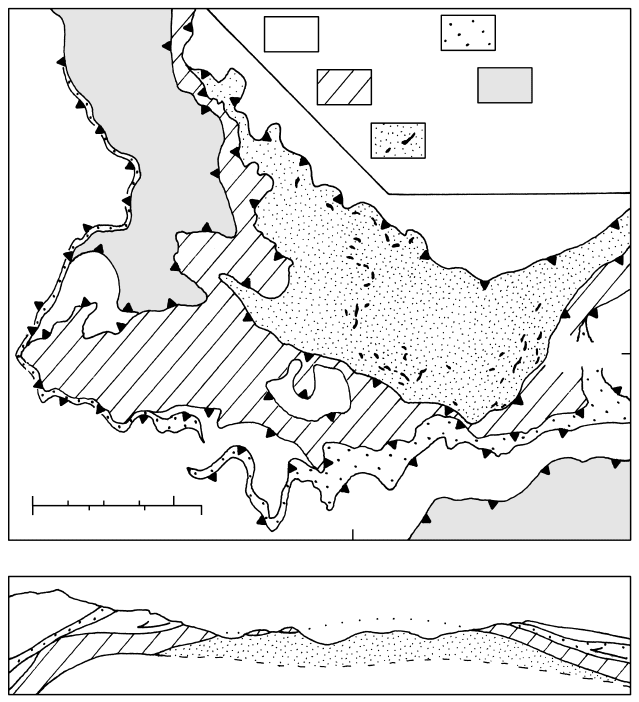
18.7.2 Dora Maira Massif in the Western Alps
The tectonic collage of metamorphic rocks that makes
up the Dora Maira Massif in the western Alps was
created during late Cretaceous–early Tertiary collision
of continental plates—the European on the north and
one or more continental plates to the south (Figures
18.6 and 18.24). (Massif is from the French massive and
connotes a large block of mountain terrain made of
relatively coarsely crystalline rocks.) UHP rocks occur
as lenses within a stack of tectonically emplaced nappes
and slices of Paleozoic schists, gneisses, marbles,
quartzites, eclogite, and Mesozoic ophiolite (Figure
18.34). Whereas protoliths in circum-Pacific high P/T
terranes are mostly oceanic rocks and near-trench
immature sediments (feldspathic and lithic debris),
Alpine protoliths are continental granitoids and more
differentiated shelf-deposited sedimentary rocks, such
as pelites and quartzites. These rocks appear to have
been metamorphosed to the blueschist and eclogite
facies but a widespread, variable greenschist-facies
overprint took place in the middle Tertiary. The tec-
tonic slices experienced different P–T histories; partly
exhumed UHP and high-P layers appear to have been
thrust over lower-P ones before final exhumation of the
entire sequence (Harley and Carswell, 1995).
Inclusions of coesite are hosted within unusually
pure (90–98 mol % end-member) pyrope poikiloblasts
as much as 20 cm in diameter whose dominant inclu-
sion is kyanite. These nearly colorless to pink pyrope
porphyroblasts occur in a kyanite-white mica–talc
quartzite, known locally as white schist. Zircon, rutile,
and jadeitic (70 mol % end-member) clinopyroxene
are accessories. The unusually high Al, Si, and Mg
and virtual absence of Ca and Na in these white schists
indicates an unusual protolith; some sort of sediment-
ary evaporite has been suggested but a metasomatized
granitoid seems more likely. The coesite-bearing white
schists occur as discontinuous layers and boudins cen-
timeters to meters thick hosted within greenschist-facies
Metamorphism at Convergent Plate Margins: P–T–t Paths, Facies, and Zones
603
0km4
0 miles 3
7°20′E
44°35′N
Miscellaneous
metam rocks
Chiefly HP
eclogite
UHP unit; lenses of
coesite-pyrope quartzite
in black
Chiefly blue-
schist facies
Ophiolite and
associated rocks
18.34 Geologic map and cross-section of the southern Dora Maira Massif in extreme northwestern Italy of the western Alps. See location in
Figure 18.6. Each of the map units consists of a variety of rock types but dominated by that indicated. In addition to small lenses of
coesite–pyrope quartzite, the UHP unit contains orthogneiss, marble, a variety of schists, and local eclogite. The slightly generalized cross
section shows the structure of the post-metamorphic dome along a west–east line at approximately 44° 30′N. All contacts appear to be
tectonic. Redrawn from Michard et al. (1995).
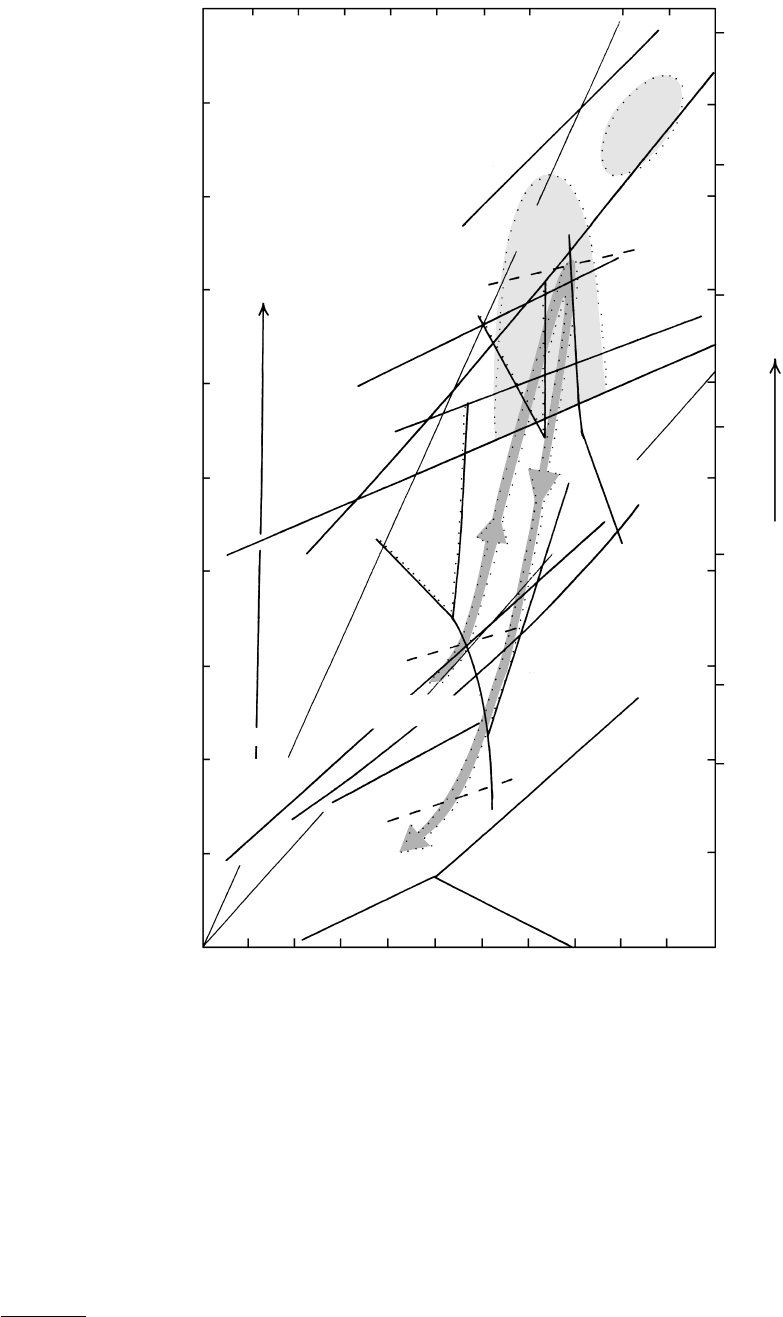
gneiss that lies in a sequence of metapelites, marbles,
and metabasites.
P T Path. Schertl et al. (1991) document critical
mineral zoning, inclusions, and reaction textures that
define the P–T path taken by the coesite-bearing white
schists during their ultradeep burial and subsequent
exhumation. These constraints can be followed in the
petrogenetic grid in Figure 18.35. The initial rock was
likely composed essentially of Mg-chlorite quartz.
604 Igneous and Metamorphic Petrology
P (kbar)
High-P (HP)
Ultrahigh-P (UHP)
Depth (km)
Normal continental crust Upper mantle
50
40
30
20
10
0
175
150
125
100
75
50
35
0
100 300 500 700 900 1100
T (°C)
And
Sil
Ky
Dora Maira
Si 3.09
Si 3.26
Si 3.55
Tlc
Ky
Tlc
Ky
Jd Qtz
Gln Zo Qtz
Chl + Qtz
Tr Ab Chl
Ab
BLUESCHIST
Arg
Cal
Mg-Car
Graphite
Diamond
Tlc Jd
Gln
Q
u
a
rtz
Coesite
Ell
Dabie–
Sulu
ECLOGITE
P
h
e
T
l
c
P
h
l
K
y
Q
t
z
P
y
p
S
i
O
2
H
2
O
G
r
t
R
t
C
s
H
2
O
G
r
t
R
t
C
s
T
t
n
K
y
T
t
n
E
p
T
l
c
K
y
10°C/km
5°C/km
Kokchetav
18.35 Petrogenetic grid for select univariant reactions pertaining to high-P (HP) and ultrahigh-P (UHP) metamorphism. UHP metamorphism
takes place in the stability field of coesite, HP in the quartz field. Broad P–T conditions for the eclogite and blueschist facies are indi-
cated. The tight clockwise P–T path for metamorphism in the Dora Maira Massif is indicated by the shaded arrow. Peak metamorphic
conditions for the UHP rocks of the Kokchetav Massif and Dabie–Sulu chiefly metasedimentary rocks are shaded. Wedge-shaped areas
ornamented by dots alongside lines are stability fields of ellenbergerite (Ell) and Mg-Carpholite (Mg-Car). Light lines show reference 5
and 10°C/km geothermal gradients. Dashed lines show Si content of phengitic mica that serves as a barometer (Massone and Schreyer,
1989). Most reaction lines drawn for unit water activity. Redrawn after Schertl et al. (1991), Harley and Carswell (1995), and Zhang et al.
(1997). Some univariant lines are from figures in this textbook.

The small amount of K in the rock probably stabilized
some additional phengitic white mica while excessive
Al stabilized kyanite. An inclusion of a phengite grain
within a relict kyanite that is in turn hosted within a py-
rope poikiloblast defines a point at 16 kbar and 560°C
on the prograde P–T path. Because of the P-sensitive
substitution SiMg b AlAl in phengite, the concentra-
tion of Si serves as a useful barometer where it coexists
with another Al-phase, such as kyanite. The phengite
inclusion contains 3.26 Si per 12 oxygen in the formula
unit, indicating equilibration at 16 kbar. At this P, the
T-sensitive reaction chlorite quartz talc kyanite
occurs at about 560°C. Further evidence for this dis-
continuous reaction lies in the absence of any relict
Mg-carpholite (Table 14.1) inclusions in any host
mineral. The next thermobarometric constraint on the
prograde P–T path is provided by the occurrence of
inclusions of purple ellenbergerite, a newly discovered
hydrous Mg–Al–Ti–Zr silicate with extensive solid
solution to a phosphate end-member that occurs as
inclusions in pyrope porphyroblasts. Silica-rich ellen-
bergerite inclusions probably formed by the reaction
chlorite kyanite rutile H
2
O → ellenbergerite
because relics of the reactant phases are also found as
inclusions around those of ellenbergerite. Its narrow
wedge-shaped stability field constrains the prograde
path to about 30 kbar and 700°C after the rock had
passed above the quartz → coesite transition. Peak P–T
conditions in the Dora Maira rocks are preserved in
Si-rich phengite and small pyrope porphyroblasts that
contain abundant coesite inclusions. Because all four
phases in the T-constraining reaction talc kyanite
pyrope coesite appear to be compatible in the rock,
equilibration must have been near 800°C, or less if
water activity was much less than 1. The 3.55 Si per
formula unit in the coexisting phengite constrains P to
about 37 kbar, just short of the diamond stability field.
In rare cases, talc jadeite, instead of the chemically
equivalent glaucophane, occur in mutual contact, sug-
gesting their stable coexistence and confirming the
peak conditions. However, retrograde glaucophane
does occur locally in cracks within garnets. A tight
restriction on the retrograde path is provided by wide-
spread partial replacement of small pyrope porphyro-
blasts by the assemblage phlogopite kyanite quartz
scapolite. Except for scapolite, this assemblage can
be related to the univariant reaction talc phengite →
phlogopite kyanite quartz. Schertl et al. (1991) be-
lieve this reaction was shifted to slightly lower temper-
atures as a result of interactions with hydrous fluids
that contained Na, Ca, and Cl, reducing the water
activity to 1 and stabilizing scapolite. Fine-grained
retrograde white micas, apparently equilibrated with
quartz kyanite chlorite, contain 3.09 Si per for-
mula unit, constraining the retrograde path to near
7 kbar at 500°C, appropriate to depths of typical lower
continental crust. Neither andalusite nor sillimanite
occur in the Dora Maira rocks, which means that the
retrograde path, after the rocks arrived at a depth of
about 20 km, must have followed a more normal ther-
mal gradient of about 20°C/km.
There are at least two alternate interpretations for
the origin of the greenschist-facies gneiss (quartz–albite
–alkali feldspar–biotite–white mica–chlorite–epidote)
adjacent to the coesite-bearing rocks. Either the gneisses
were never subjected to UHP metamorphism and were
tectonically intercalated with the coesite-bearing rocks
during their transit through the shallow crust, or the
gneisses were pervasively retrograded from an UHP
condition during exhumation. The latter interpretation
is strengthened by the occurrence of relic phengitic
mica grains that were equilibrated at high P and by rare
armored relics of grossular-rich (85 mol %) garnet and
rutile in almandiferous garnet. Figure 18.35 shows that
grossular-rich garnet is stable with rutile and coesite
near 30 kbar and 800°C.
18.7.3 Dabie–Sulu Terranes
These terranes in east-central China are a segment of
a 2000-km-long continental suture zone defined by
high-P eclogite- and blueschist-facies rocks between
two Precambrian cratons (Figure 18.36). Following
subduction of the seafloor in the late Paleozoic,
the northward moving Yangtze continental mass was
Metamorphism at Convergent Plate Margins: P–T–t Paths, Facies, and Zones
605
18.36 Geologic map of the Dabie–Sulu UHP terrane and associated
rocks in the Triassic suture zone between the Precambrian
Sino-Korean and Yangtze Cratons in east-central China.
Redrawn from Wang et al. (1995). Heavier lines are faults,
including a major north–south strike-slip fault that has dis-
placed the UHP Sulu terrane from the once continuous Dabie
terrane.
S
N
112°E 120°E
0 300km
0 200miles
Dabie
CRATON
YANGTZE
Sea
Sulu
36°N
32°
Yellow
Beijing
SINO-
KOREAN
CRATON
Greenschist
facies
Amphibolite-
granulite facies
Blueschist
facies
High-P eclogite
UHP rocks

jammed below the edge of the Sino-Korean continent
in the late Triassic, 240–230 Ma, creating the UHP
rocks now exposed over an area of about 1000 km
3
.
Associated tectonites to the north in the Dabie terrane
are amphibolite- and granulite-facies felsic gneisses and
migmatites, whereas to the south, across a possible
detachment surface marked by mélange, more varied
rocks include felsic gneiss, paraschist, marble, ultra-
mafic rocks, and lenses and layers of eclogite hosted
within them.
Coesite and coesite relics occur as inclusions in gar-
net, clinopyroxene, kyanite, dolomite, and zircon. Rare
microdiamond inclusions and armored relics of grossular-
rich garnet and rutile in eclogite garnets indicate pres-
sures 30 kbar at 700°C (Figure 18.35). UHP rocks
are pervasively overprinted by amphibolite-facies assem-
blages. Bolin et al. (1999) believe the UHP rocks were
exhumed in three stages between 230 and 120 Ma.
18.7.4 Evolution of UHP Terranes
Until the 1980s, subducting plates were believed to be
essentially restricted to those of oceanic lithosphere;
continental lithosphere with its thick, significantly
less dense crust was deemed to be just too buoyant
to subduct into the mantle. In the classic continent–
continent collision zone of the Himalaya, the Eurasian
plate in Tibet is underthrust at a shallow angle by the
Indian continent so that the deepest part of the Moho
lies at depths of “only” 70–80 km (Figure 13.33); the
underthrust continental plate does not penetrate into
the mantle. However, the dogma that continental plates
cannot subduct was overturned in the 1980s with
discoveries of coesite and diamond in continental
protoliths that must have been buried twice as deep, to
depths of 120–160 km (Figure 18.35).
In trying to understand the tectonothermal evolu-
tion of UHP terranes it is significant that not only were
they buried to great depth but they are also restricted
to continental, not oceanic, protoliths in elongate
continent–continent suture zones. Protoliths followed
relatively refrigerated P–T paths during burial and
exhumation. After initial burial along an approximate
trajectory of 10°C/km to about 560°C at 55–60 km, the
Dora Maira rocks were subsequently transferred to
800°C at about 130 km (Figure 18.35) along a trajec-
tory of a little more than 3°C/km. Decompression
followed along a similar trajectory to about 30 km.
This path precludes sufficient heating to create partial
melting—hence the virtual absence of coeval silicic
magmatism (Figure 18.6) like the Himalaya granites
(Figure 13.33). More mafic calc–alkaline magmatism of
the Andean type (Section 13.7) is also absent because
there is no subducting and water-liberating oceanic
crust to foster generation of magmas in the arc mantle.
What seems to be required is rapid subduction and
return exhumation of cold continental lithosphere.
Just how rapid is revealed by chronologic analyses
of minerals in assemblages that also yield thermobaro-
metric data on P–T paths. SHRIMP analyses (see
Special Interest Box 19.1) for U–Th–Pb isotopes in
titanite grains in the Dora Maira rocks yield an age of
35.1 0.9 Ma for the metamorphism at maximum P
(35 kbar near 125 km depth; Rubatto and Hermann,
2001). Retrograde titanites equilibrated at about 35 km
depth yield an age of 32.9 0.9 Ma, indicating as-
tounding exhumation rates of a few centimeters per
year (the exact rate must take into account the uncer-
tainty errors in the chronologic and barometric ana-
lyses). Subsequent slower exhumation at about 0.5 cm/y
brought the UHP rocks to a depth of about 10 km and
250°C at 29.9 1.4 Ma, based on annealing of fission
tracks in zircon. Chronologic data on the coesite-bearing
rocks at the western end of the middle Tertiary
Himalaya and diamond-bearing rocks of the 500 Ma
Kokchetav and 210 Ma Dabie–Sulu have larger analyt-
ical uncertainties but are of similar magnitude (centi-
meters per year).
Such astounding rates of exhumation of low-density,
refrigerated continental rocks from mantle depths
appear to be required for preservation of UHP
metamorphism. (One is reminded of the response
of a basketball pushed into the water in a swimming
pool; once released the buoyant ball rapidly pops
back to the surface.) One possible scenario (O’Brien
et al., 2001) involves break-off of the leading, denser
oceanic part of the descending slab that was acted
on by a slab-pull force earlier in the subduction
process. Once freed of its denser leading part, the
buoyant continental material can pop up to the top of
the mantle at rates of centimeters per year. Subsequent
slower rates of exhumation occur as more normal iso-
static rebound takes place in the imbricate stack of
thrust slices.
SUMMARY
Metamorphic zones, facies, and P–T paths provide im-
portant constraints on dynamic tectonic and thermal
phenomena at convergent plate junctures during
orogeny. The nature of the plates, whether continental
or oceanic, their thermal state and thickness, rate of
convergence, distribution of radioactive heat sources,
and rate of unroofing govern the conductive thermal
evolution of orogens and the metamorphic terranes
in them. Faster convergence rates tend to counteract
the heating effect via thermal relaxation of thickened
crust that largely controls the prograde path of meta-
morphism. Rapid unroofing—by tectonic extensional
faulting or erosion or both—leads to steep thermal
gradients near the surface of the Earth and nearly iso-
thermal, retrograde decompression metamorphic paths.
606 Igneous and Metamorphic Petrology
